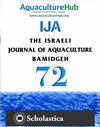Effects of thermal stratification and mixing on the vertical distribution of dissolved oxygen in aquaculture ponds
IF 0.5
4区 农林科学
Q4 FISHERIES
引用次数: 1
Abstract
Thermal stratification and mixing in aquaculture ponds can seriously affect the vertical distribution of dissolved oxygen (DO) and result in a lack of DO in ponds. Therefore, revealing the vertical distribution of DO in aquaculture ponds influenced by thermal stratification and mixing can provide a theoretical basis for aquaculture water management. Here, we explore the impacts of thermal stratification and mixing on the vertical distribution of DO in two aquaculture ponds under different weather conditions. The results showed that thermal stratification mainly occurs during the daytime, and mixing occurs at nighttime. Water thermal stratification appears 4 h after sunrise, while mixing occurs 1 h after nightfall. When the Richardson index is less than 0.25, the mixing direction is unstable. In the daytime, the vertical distribution of DO, chlorophyll a (Chl-a), and phytoplankton abundance varied with thermal stratification and mixing. The concentration of DO gradually dropped with increasing water depth during the nighttime. The concentration of DO was lowest in the early morning and peaked in the afternoon. Multiple regression analysis demonstrated that water temperature (WT), Chl-a, and phytoplankton abundance provided the best model for the vertical distribution of DO. Based on our results, DO regulation can provide important insights for aquaculture pond management.热分层和混合对水产养殖池塘溶解氧垂直分布的影响
养殖池塘的热分层和混合会严重影响溶解氧(DO)的垂直分布,导致池塘中DO缺乏。因此,揭示受热分层和混合影响的养殖池塘DO的垂直分布可以为养殖水体管理提供理论依据。本研究探讨了不同天气条件下,热分层和混合对两个养殖池塘DO垂直分布的影响。结果表明:热分层主要发生在白天,混合主要发生在夜间。日出后4 h出现水热分层,而夜幕降临后1 h出现混合。当Richardson指数小于0.25时,混合方向不稳定。在白天,DO、叶绿素a (Chl-a)和浮游植物丰度的垂直分布随热分层和混合而变化。夜间,DO浓度随水深的增加而逐渐下降。DO浓度在清晨最低,下午最高。多元回归分析表明,水温、Chl-a和浮游植物丰度是DO垂直分布的最佳模型。基于我们的研究结果,DO调控可以为水产养殖池塘管理提供重要的见解。
本文章由计算机程序翻译,如有差异,请以英文原文为准。
求助全文
约1分钟内获得全文
求助全文
来源期刊
CiteScore
0.90
自引率
16.70%
发文量
49
审稿时长
3 months
期刊介绍:
Information not localized

 求助内容:
求助内容: 应助结果提醒方式:
应助结果提醒方式:


